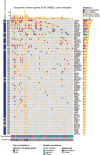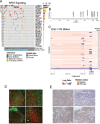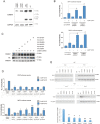The Genetic Landscape of Ocular Adnexa MALT Lymphoma Reveals Frequent Aberrations in NFAT and MEF2B Signaling Pathways
- PMID: 35528192
- PMCID: PMC9075502
- DOI: 10.1158/2767-9764.crc-21-0022
The Genetic Landscape of Ocular Adnexa MALT Lymphoma Reveals Frequent Aberrations in NFAT and MEF2B Signaling Pathways
Erratum in
-
Correction: The Genetic Landscape of Ocular Adnexa MALT Lymphoma Reveals Frequent Aberrations in NFAT and MEF2B Signaling Pathways.Cancer Res Commun. 2023 Aug 29;3(8):1688. doi: 10.1158/2767-9764.CRC-23-0371. eCollection 2023 Aug. Cancer Res Commun. 2023. PMID: 37649813 Free PMC article.
Abstract
A comprehensive constellation of somatic non-silent mutations and copy number (CN) variations in ocular adnexa marginal zone lymphoma (OAMZL) is unknown. By utilizing whole-exome sequencing in 69 tumors we define the genetic landscape of OAMZL. Mutations and CN changes in CABIN1 (30%), RHOA (26%), TBL1XR1 (22%), and CREBBP (17%) and inactivation of TNFAIP3 (26%) were among the most common aberrations. Candidate cancer driver genes cluster in the B-cell receptor (BCR), NFkB, NOTCH and NFAT signaling pathways. One of the most commonly altered genes is CABIN1, a calcineurin inhibitor acting as a negative regulator of the NFAT and MEF2B transcriptional activity. CABIN1 deletions enhance BCR-stimulated NFAT and MEF2B transcriptional activity, while CABIN1 mutations enhance only MEF2B transcriptional activity by impairing binding of mSin3a to CABIN1. Our data provide an unbiased identification of genetically altered genes that may play a role in the molecular pathogenesis of OAMZL and serve as therapeutic targets.
Keywords: CABIN1; MEF2B; Marginal zone lymphoma; NFAT; Orbital adnexa lymphoma.
Conflict of interest statement
DISCLOSURE OF CONFLICTS OF INTEREST The authors declare no conflicts of interest related to this study
Figures







Similar articles
-
The mutational landscape of ocular marginal zone lymphoma identifies frequent alterations in TNFAIP3 followed by mutations in TBL1XR1 and CREBBP.Oncotarget. 2017 Mar 7;8(10):17038-17049. doi: 10.18632/oncotarget.14928. Oncotarget. 2017. PMID: 28152507 Free PMC article.
-
High throughput sequencing reveals high specificity of TNFAIP3 mutations in ocular adnexal marginal zone B-cell lymphomas.Hematol Oncol. 2020 Aug;38(3):284-292. doi: 10.1002/hon.2718. Epub 2020 Feb 16. Hematol Oncol. 2020. PMID: 32012328
-
Recurrent mutations in NF-κB pathway components, KMT2D, and NOTCH1/2 in ocular adnexal MALT-type marginal zone lymphomas.Oncotarget. 2016 Sep 20;7(38):62627-62639. doi: 10.18632/oncotarget.11548. Oncotarget. 2016. PMID: 27566587 Free PMC article.
-
MALT lymphoma: A paradigm of NF-κB dysregulation.Semin Cancer Biol. 2016 Aug;39:49-60. doi: 10.1016/j.semcancer.2016.07.003. Epub 2016 Jul 21. Semin Cancer Biol. 2016. PMID: 27452667 Review.
-
The Biology of Ocular Adnexal Marginal Zone Lymphomas.Cancers (Basel). 2022 Feb 28;14(5):1264. doi: 10.3390/cancers14051264. Cancers (Basel). 2022. PMID: 35267569 Free PMC article. Review.
Cited by
-
Clinical relevance of molecular aspects in extranodal marginal zone lymphoma: a critical appraisal.Ther Adv Med Oncol. 2023 Jun 22;15:17588359231183565. doi: 10.1177/17588359231183565. eCollection 2023. Ther Adv Med Oncol. 2023. PMID: 37389189 Free PMC article. Review.
-
SOHO State of the Art Updates and Next Questions | Current and Emerging Novel Treatments for Marginal Zone Lymphoma.Clin Lymphoma Myeloma Leuk. 2025 May 31:S2152-2650(25)00198-3. doi: 10.1016/j.clml.2025.05.021. Online ahead of print. Clin Lymphoma Myeloma Leuk. 2025. PMID: 40581510 Review.
-
Correction: The Genetic Landscape of Ocular Adnexa MALT Lymphoma Reveals Frequent Aberrations in NFAT and MEF2B Signaling Pathways.Cancer Res Commun. 2023 Aug 29;3(8):1688. doi: 10.1158/2767-9764.CRC-23-0371. eCollection 2023 Aug. Cancer Res Commun. 2023. PMID: 37649813 Free PMC article.
-
Enhancing prognostication and personalizing treatment of extranodal marginal zone lymphoma.Expert Rev Hematol. 2023 May;16(5):333-348. doi: 10.1080/17474086.2023.2206557. Epub 2023 Apr 28. Expert Rev Hematol. 2023. PMID: 37086394 Free PMC article. Review.
-
A roadmap for clinical trial design in marginal zone lymphoma.Am J Hematol. 2022 Nov;97(11):1398-1403. doi: 10.1002/ajh.26706. Epub 2022 Sep 12. Am J Hematol. 2022. PMID: 36030403 Free PMC article.
References
Publication types
MeSH terms
Substances
Grants and funding
LinkOut - more resources
Full Text Sources
Medical
Molecular Biology Databases

